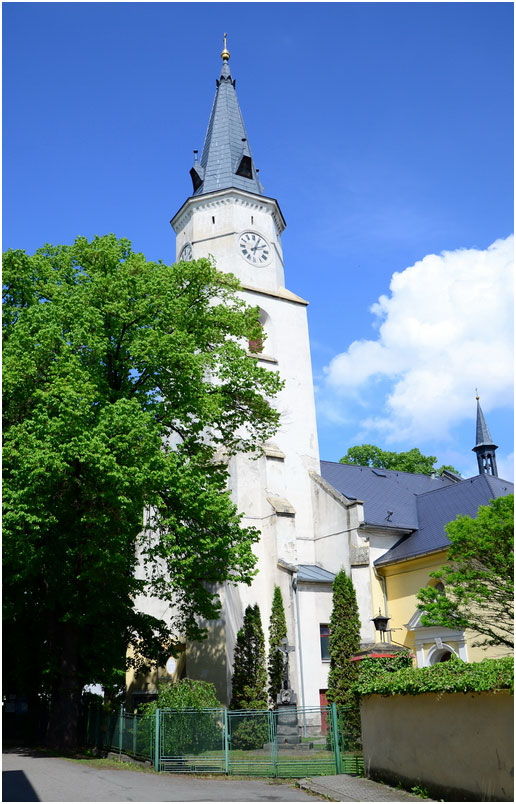











The origins of the Church of the Nativity of the Virgin Mary in Starý Bohumín, the oldest cultural monument on the territory of Bohumín, whose spiritual administrators were Benedictines around the middle of the 13th century, remain shrouded in mystery due to unpreserved historical records. The local monastic community allegedly consisted of the provost and six other religious brothers from the home monastery of Týnec near Krakow in Poland. The first wooden chapel probably stood here at the turn of the 12th and 13th centuries. It was probably replaced by a Gothic brick church between 1320 and 1400.
After the death of the last Ratibork prince Valentin from the Přemyslov family in 1521 and the Opole prince Jan from the Piast family in 1523, the Bohumín estate was acquired by pledge into his possession by the Krnov prince Jiří from the Ansbach branch of the Hohenzollern family. He soon gave it to his son Georg Friedrich Hohenzollern. Members of this family soon began to lean towards Protestantism of the Augsburg confession instead of Catholicism. Their heirs were the Electors of Brandenburg, who gravitated towards Calvinism for a change, and the local population, according to the principle of "whose land, whose faith", was "forced" to accept the faith of their new overlord.
The Bohumín church was allegedly taken from the Benedictines in 1530 and entrusted to the care of Protestant pastors of the Augsburg denomination. The inscriptions, which were placed on the walls of the Bohumín church by the Benedictines, were not removed until almost a hundred years later on the basis of the order of the Prince of Těšín, Václav Adam. Jiří Floderus, the only known Protestant pastor from Fryštát, was commemorated in Bohumín in 1620 in connection with the completed extensive renaissance reconstruction of the church.
For the newly built church tower, he purchased two bells (Adam and Joseph) with a large silver content, made in the Opava bell-making workshop of Hans Knauff (confiscated for war purposes in 1942, but returned in 2014). A gradual return to Catholicism occurred only from 1621, after the defeat of the mercenary army of Johann Georg Krnovský, son of the Krnov prince and Elector of Brandenburg Joachim Friedrich. It was then that Emperor Ferdinand II., who on January 22, 1621, definitively deprived the rebellious Krnov prince of the Bohumín and Bytom estates, confirmed the lien on Bohumín and Bytom from May 17, 1618 to the Prague banker Lazarus II. Henckel from Donnersmarck and Vösendorf, professing Protestant pietism.
The Bohumín church, the patronage of which was now exchanged for himself by the monarch himself, was taken from the Protestants sometime in the second half of 1629 after the sale of Bohumín to Eliáš Henckel. In the same year, Jan Fridrichowski became the new spiritual administrator here. However, when the Orlov monastery was returned to the Benedictines from Týnec near Krakow in restitution, the Bishop of Wrocław, Karel Ferdinand Waza, allowed them to take over the newly vacated Bohumín parish ring in 1631. This then included the settlements of Bohumín, Dvorek, Gorzyce (PL), Chałupki (PL), Kopytov, Łaziska (PL), Olza (PL), Pudlov, Rudyszwałd (PL), Šunychl, Vrbice and Zabełków (PL).
The economic background of the monastery, such as the settlements of Orlová, Lutyně, Rychvald, however, were not returned. Athanasius Stanislawski thus became the first Orlov abbot residing in Bohumín. But he and his successors mostly stayed in the mother monastery and were represented here by commanders. Due to continuous neglect of their duties as administrators of the Bohumín parish, the local parish ring was taken away from them in 1669, and diocesan priests were appointed to the vacant post of the Bohumín parish priest until the arrival of the lesser Franciscan brothers from the home monastery in Polish Katowice-Panewnik in 1993. In 1668, parishioners from the affiliated villages of Olza, Gorzyc and Łazisk built a chapel of St. Jana.
To change its dedication to the chapel of St. John of Nepomuck could have happened only after the saint's canonization, which took place on March 19, 1729. A few years later, in 1688 at the latest, the chapel of Our Lady of the Rose was added to the south side. The floor plan of the church thus briefly acquired the shape of a Latin cross. The chapel was rebuilt to its present form in 1721. Under the floor of the northern St. John's chapel, a crypt with an area of approx. 20 m2 was also set up at the expense of the owners of the Bohumín manor sometime around this time, in which burials were carried out until the second half of the 18th century.
The tombstones of the buried clergy and nobles, placed in the floor of the chapel, were allegedly covered with new paving in 1900. On the night of April 14-15, 1779, an unknown band of thieves robbed the local church so completely that nothing of value was left. At the time, the damage was estimated at an incredible 1968 Rhenish gold.










